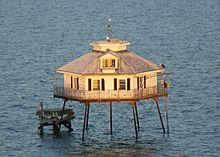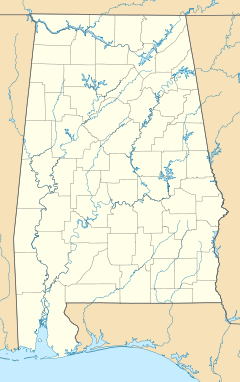- Middle Bay Light
-
Middle Bay Light 
Middle Bay Light in Mobile Bay, near Mobile, Alabama. Location Mobile Harbor, Mobile Bay, Alabama Coordinates 30°26′17.60″N 88°0′40.48″W / 30.438222°N 88.0112444°W Year first constructed 1885 Year first lit 1885 Automated 1935 Deactivated 1967 Foundation Screw piling with platform Construction Wood Tower shape Hexagonal Height 41 feet Original lens Fourth order Fresnel lens, 1885 Characteristic Fixed white varied by a red flash every 30 seconds, bell struck by machinery every 5 seconds. Middle Bay Light Middle Bay Light circa 1940.
Middle Bay Light circa 1940.Location: Middle of Mobile Bay, Mobile Bay, Alabama Coordinates: 30°26′10″N 88°1′5″W / 30.43611°N 88.01806°WCoordinates: 30°26′10″N 88°1′5″W / 30.43611°N 88.01806°W Built: 1885 Architect: Unknown Governing body: COAST GUARD NRHP Reference#: 74000429[1] Added to NRHP: December 30, 1974 Middle Bay Light, also known as Middle Bay Lighthouse and Mobile Bay Lighthouse, is a hexagonal-shaped screw-pile lighthouse offshore from Mobile, Alabama, in the center of Mobile Bay.
Contents
History
The station was activated in 1885. In 1916 the keeper's wife gave birth to a baby that summer at the station. According to the Alabama Lighthouse Association web site, the keeper brought a dairy cow to the station and corralled it on a section of the lower deck because his wife was unable to nurse the newborn baby. All had to be evacuated when the station survived but was damaged by a hurricane that year. The light was automated in 1935.
Middle Bay Light was deactivated in 1967. The lighthouse was placed on National Register of Historic Places on December 30, 1974.[1] In 1984 the lighthouse was stabilized by Middle Bay Light Centennial Commission in preparation for the centennial celebration. In 1996 the Coast Guard loaned the original Fresnel lens to the Ft. Morgan Museum for public display. In 2002 restoration efforts were begun to repair the lighthouse.
Fresnel lens
Main article: Fresnel lensThe Fresnel Lens was named for Augustin Jean Fresnel, a French physicist who, in 1828, demonstrated the wave theory of light and changed the entire world's lighthouse illumination to the Fresnel System. The Fresnel lens collected the light radiated at random from a small light source and directed the rays to the horizon.[2]
Whale oil was the first fuel used and the lighthouse tenders worked in shifts making sure that the lamps did not go out and smoke the lens. In later years kerosene was used and eventually they were converted to electricity.[2]
See also
- Mobile Point Range Lights
- Sand Island Light (Alabama)
References
- ^ a b "National Register Information System". National Register of Historic Places. National Park Service. 2008-04-15. http://nrhp.focus.nps.gov/natreg/docs/All_Data.html.
- ^ a b "The Fresnel Lens". BrownMarine.com. http://www.brownmarine.com/mobilebay.htm. Retrieved 2007-04-23.
External links
- Alabama Lighthouse Association.
- Rowlett, Russ. "Lighthouses of the United States:Alabama". The Lighthouse Directory. University of North Carolina at Chapel Hill. http://www.unc.edu/~rowlett/lighthouse/al.htm.
- Lighthouse Friends, Middle Bay Light.
U.S. National Register of Historic Places Topics Lists by states Alabama • Alaska • Arizona • Arkansas • California • Colorado • Connecticut • Delaware • Florida • Georgia • Hawaii • Idaho • Illinois • Indiana • Iowa • Kansas • Kentucky • Louisiana • Maine • Maryland • Massachusetts • Michigan • Minnesota • Mississippi • Missouri • Montana • Nebraska • Nevada • New Hampshire • New Jersey • New Mexico • New York • North Carolina • North Dakota • Ohio • Oklahoma • Oregon • Pennsylvania • Rhode Island • South Carolina • South Dakota • Tennessee • Texas • Utah • Vermont • Virginia • Washington • West Virginia • Wisconsin • WyomingLists by territories Lists by associated states Other  Category:National Register of Historic Places •
Category:National Register of Historic Places •  Portal:National Register of Historic Places
Portal:National Register of Historic PlacesNational Register of Historic Places in Mobile County, Alabama Historic districts Barr's Subdivision Historic District | Bellingrath Gardens and Home | Central Core Historic District | Chickasaw Shipyard Village Historic District | Citronelle Railroad Historic District | Davis-Oak Grove District | Grand Bay Historic District | Mount Vernon Arsenal-Searcy Hospital Complex

Other properties Hiram B. Austin House | Bishop Manor Estate | Willis G. Clark House | Ellicott Stone | Fort Gaines | Charles Denby Garrison Sr. House | Indian Mound Park | George Leatherbury House | Magee Farm | Middle Bay Light | Nanna Hubba Bluff | Old Mobile Site; Fort Louis De La Louisiane | Tanner Farmhouse | N.Q. and Virginia M. Thompson House
Mobile (city) See also: National Register of Historic Places listings in Mobile County, Alabama and List of National Historic Landmarks in Alabama Categories:- National Register of Historic Places in Mobile County, Alabama
- Lighthouses on the National Register of Historic Places
- Lighthouses in Alabama
- Buildings and structures in Mobile, Alabama
- Buildings and structures completed in 1885
- Alabama State Historic Sites
- Alabama building and structure stubs
- United States lighthouse stubs
Wikimedia Foundation. 2010.

